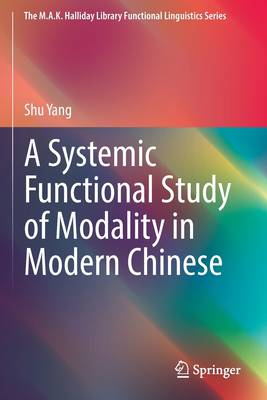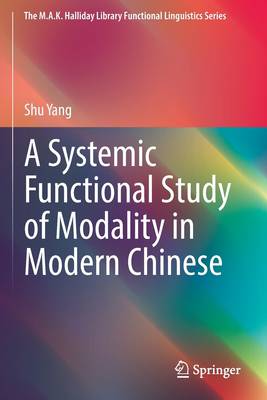
- Afhalen na 1 uur in een winkel met voorraad
- Gratis thuislevering in België vanaf € 30
- Ruim aanbod met 7 miljoen producten
- Afhalen na 1 uur in een winkel met voorraad
- Gratis thuislevering in België vanaf € 30
- Ruim aanbod met 7 miljoen producten
Omschrijving
1.1 Preamble
1.2 Background to the research
1.3 Theoretical framework
1.4 Research questions1.5 Data and methodology
1.6 The organization of the book
2 Literature Review
2.1 Introduction
2.2 Modality in English
2.3 Modality in Modern Chinese
2.4 Modality in SFL
2.4.1 Halliday (1985, 1994); Halliday & Matthiessen (2014)2.4.2 Thompson (1996, 2004, 2013)
2.4.3 Martin (1990, 1992); Martin & White (2005); Martin & Rose (2007)
2.4.4 Fawcett (2008, forthcoming)
2.4.5 Zhu (1985, 1996); Halliday & McDonald (2004); Li (2007)
3 Systemic Functional Theory Revisited
3.1 Introduction
3.2 SFL as a general linguistic theory3.3 The "architecture" of language
3.3.1 Stratification
3.3.2 Instantiation
3.3.3 Metafunction
3.3.4 Axis (paradigmatic organization)
3.3.5 Axis (syntagmatic organization)
3.3.6 Rank
3.4 Reasons for adopting the systemic functional approach
3.5 Summary
4 A Short Overview of Chinese Lexicogrammar
4.1 Introduction
4.2 Interpersonal meaning - the system of MOOD
4.3 Experiential meaning - the system of TRANSITIVITY
4.4 Textual meaning - the system of THEME and INFORMATION
4.5 Logical meaning - the systems of TAXIS and LOGICO-SEMANTIC TYPES
5 The System of Types of Modality
5.1 Introduction
5.2 Two major types of modality5.3 Modulation
5.3.1 Obligation
5.3.2 Inclination
5.3.3 Ability5.4 Modalization: probability
5.4.1 Certainty
5.4.2 Median probability
5.4.3 Possibility5.5 Usuality in Chinese
5.6 Summary
6 The System of Realization of Types of Modality
6.1 Introduction
6.2 Modalization: the system of ORIENTATIONS
6.3 Modulation: the system of ORIENTATION
6.4 The notion of "cline"
7 Realizations of Modality in the Textual Structure of Clause
7.1 Introduction
7.2 Realizations of modality in the thematic structure
7.2.1 Modal adverbs of probability as the interpersonaSpecificaties
Betrokkenen
- Auteur(s):
- Uitgeverij:
Inhoud
- Aantal bladzijden:
- 175
- Taal:
- Engels
- Reeks:
Eigenschappen
- Productcode (EAN):
- 9789811680229
- Verschijningsdatum:
- 12/12/2022
- Uitvoering:
- Paperback
- Formaat:
- Trade paperback (VS)
- Afmetingen:
- 156 mm x 234 mm
- Gewicht:
- 276 g

Alleen bij Standaard Boekhandel
Beoordelingen
We publiceren alleen reviews die voldoen aan de voorwaarden voor reviews. Bekijk onze voorwaarden voor reviews.











